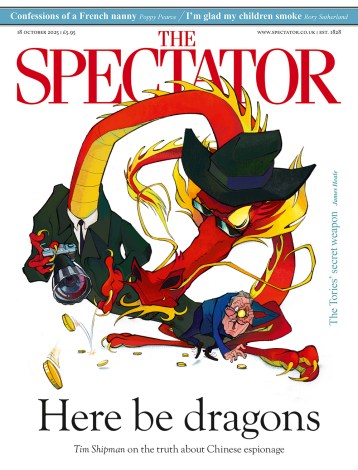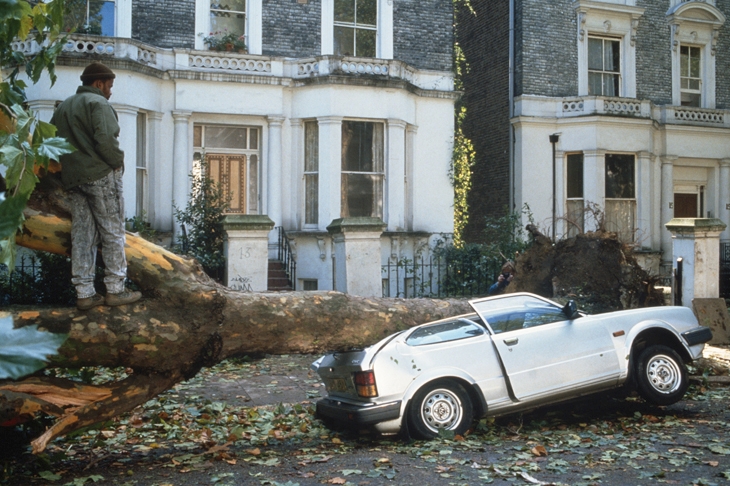The Great Storm of 1987 doesn’t have a name like those hurricanes that devastate the Caribbean and the United States each winter — it wasn’t until Abigail in November 2015 that British storms were given a personality — but it deserves its capital letters.
The worst storm to hit England since 1703 killed 18 people, felled 15 million trees, famously reducing Sevenoaks to Oneoak, and cost the insurance industry more than £2 billion. It also left the City, where trading was closed at lunchtime the next day, unprepared for the Wall Street crash that led to Black Monday on 19 October.
The storm, which struck 30 years ago this Sunday, left such a mark on the nation that it even featured in the opening ceremony of the 2012 Olympic Games. Between the theme music from The Archers and ‘Push the Button’ by the Sugababes, there was a snatch of Michael Fish’s infamously understated weather forecast. ‘Earlier on today, apparently, a woman rang the BBC and said she heard there was a hurricane on the way,’ Fish said. ‘Well, if you’re watching, don’t worry, there isn’t.’
He was technically correct. What raged over Britain that night was not a hurricane but a violent extratropical cyclone boosted by a phenomenon known as a ‘sting jet’ with gusts of force 12 on the Beaufort Scale. To my 11-year-old self, however, huddled behind a wall in the middle of the night as the gable end of our house was deposited on to my mother’s car, it certainly felt like a hurricane.
My family lived on Mersea Island, off the coast of Essex, in a semi-detached Victorian villa up the hill from the sea. Our immediate neighbours were single-storey buildings. The storm struck our house off a long run-up.
The wind had been bad all night. Gusts of 70 knots (81mph) blew for three or four hours, and none of us had been able to sleep but we were still in our own bedrooms at 2 a.m. when there was a frantic knocking on the door. Len Harvey, the caretaker of our local school, had braved the bad weather to check on his buildings and had seen our roof start to disintegrate.
As the slates and bricks rained down, he ordered us out of the house — my parents, my eight-year-old brother, Tom, and myself — and shepherded us, crouching, towards a garden wall, where we saw the upper storey of our house peel away, crushing the car below. My mother recalls hearing a roaring sound as we left ‘like a train rushing through the attic’. The 2.10 from Biscay to The Wash was a non-stopping service, and had it not been for that caretaker we might have been carried off down the line with our loft insulation.
Our half of the semi was the exit route. Next door, owned by a delightfully eccentric widow called Becky, took the impact. But Becky was in no hurry to leave. She had a friend, Phyllis, staying with her and, having lived through the Blitz, they saw no threat in mere weather.
‘But we’re in our nighties,’ Becky protested, when told she had to leave immediately. ‘And neither of us is wearing any make-up.’ Mercifully, they gave in: it later turned out that part of the chimney breast had fallen on to Phyllis’s bed.
The air, I recall, had a strange green glow, a common phenomenon in severe storms. Dust and sand swirled around us, filling our lungs as we moved away from the site. When we reached the caretaker’s house, I suffered a bad asthma attack and spent most of the next week in hospital.
The family returned in the morning to a scene of devastation. There was a huge hole in the side of our house, the bricks stripped away around my brother’s bedroom window. The car’s roof was caved in and the doors splayed wide. My father was amused to be asked by the insurance company, after ticking the ‘Act of God’ box, how much it would cost to repair.
We were homeless for three months, put up first in a hotel and then in rented property as the house was rebuilt. Our two dogs, who had been rescued by the fire brigade, were housed elsewhere. The younger one, a labrador puppy, became so badly affected by nerves afterwards that she had to be put down on the advice of the vet.
Yet our story had a happy ending. It was during our evacuation that my mother, after many years of trying for a third child, became pregnant with my sister, Rosie. Out of the thunderous, roaring devastation of the storm came the more pleasing sound of a baby’s cry.






Comments